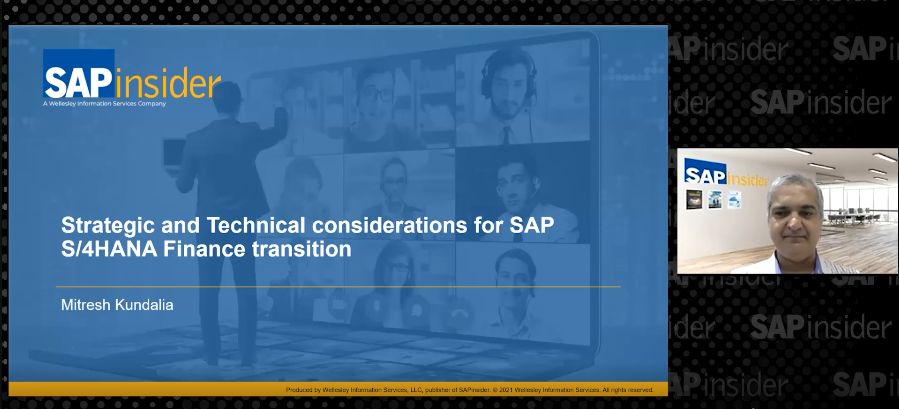Transition to SAP S/4HANA Finance
Strategic and Technical Considerations
There are myriad options associated with a transition to SAP S/4HANA Finance, and navigating all the choices can be challenging. It’s important to make sure that you chart your optimal road map to SAP S/4HANA Finance based on the specific needs of your organization.
Read the Q&A transcript with Quality Systems & Software’s Mitresh Kundalia to get expert advice on the various considerations associated with a migration, implementation, or upgrade to SAP S/4HANA Finance.
There are myriad options associated with a transition to SAP S/4HANA Finance, and navigating all the choices can be challenging. It’s important to make sure that you chart your optimal road map to SAP S/4HANA Finance based on the specific needs of your organization.
Read the Q&A transcript with Quality Systems & Software’s Mitresh Kundalia to get expert advice on the various considerations associated with a migration, implementation, or upgrade to SAP S/4HANA Finance.
Explore related questions
Kendall Hatch: Hello, and welcome to today’s Live Q&A, “Transition to SAP S/4HANA Finance: Strategic and Technical Considerations.” We’re looking forward to a lively discussion! Thanks to everyone who has submitted their questions in advance.
We’re joined for today’s event by Mitresh Kundalia of Quality Systems & Software. Mitresh is a frequent speaker and contributor at SAPinsider, and is presenting an in-depth, 3-hour pre-conference session on this topic at the upcoming SAPinsider Financials conference, Feb. 12-15, in Las Vegas. To learn more, click here.
Now, I’ll turn it over to Mitresh to start taking your questions. Thanks for joining us, Mitresh!
Mitresh Kundalia: Thank you Kendall. Hey … happy to be here … I am very pleased to be part of this live Q&A event! Let’s get started with questions.
Comment From Warren: What is the difference of just using FI/CO in SAP S/4HANA and SAP S/4HANA Finance?
Mitresh Kundalia: Thanks, Warren … Good question … There is a very common misunderstanding in general, especially with different terminologies having overlapping meanings — SAP S/4HANA, Suite on SAP HANA, Simple Finance, Smart G/L, Finance in SAP S/4HANA Accounting powered by SAP HANA, to name a few.
In very simple terms, FICO modules of traditional ECC are dramatically simplified. What were 2 separate modules in ECC as FI and CO are combined into 1; key being, it’s not just the merging of 2 modules, but significant change — 1 unified code block, combining FI CO AA and even Material Ledger; 1 unified and simplified FI … that commonly known as Simple Finance. Continuing the simplification, SAP has even simplified other modules such as SD/MM that became Simple Logistics, and expanded further to all the modules (the whole enterprise) to be commonly known as SAP S/4HANA. With that, SAP S/4HANA Finance is just a Finance sub-set of SAP S/4HANA. Another way to think is Simple Finance as analogous to SAP S/4HANA Finance.
Comment From Pranab: Hi Mitresh, we have 2 SAP instances, 1 in SAP ECC 6.0 with Classical GL and another in R/3 4.7V.What should be our ideal migration strategy without much disruption? As we do not want greenfield implementation.
Mitresh Kundalia: Interesting question … Knowing that the greenfield option does not work for you and you have 2 ERP systems … For this situation, “Central Finance” maybe an option you may want to consider. Basically, Central Finance is a way to start leveraging the power of SAP S/4HANA Finance without disrupting the existing systems. The way it will work is the FI and CO modules of your existing ECC are NOT changed but are replicated to SAP S/4HANA FI/CO modules. This is done using the ALE. The existing FICO data is replicated to SAP S/4HANA real-time.
Note: Earlier “Central Finance” was also known as “Central Journal”.
Saying that, please understand the possible downsides also. For example, if the organization has one global centralized ERP, then having Central Finance may not give the most business value. Implementing Central Finance for organizations with a DE-centralized ERP landscape, gives the most business value.
Comment From Pranab: What is the best strategy to move R/3 4.7 version to SAP S/4HANA Finance.? Is Central Finance the only option?
Mitresh Kundalia: Pranab, for this situation, there are a couple of options. Option 1 would be to do a traditional upgrade first … and then convert to SAP S/4HANA. Option 2 would be to consider Central Finance as a deployment option as well.
Please also consider other key factors such as systems landscape, functionalities in-scope, any transformation initiatives planned.
Comment From Nico: In our organization we have a very strong emphasis on automation and simplifying the various finance processes for the business. Automation does not come very standard and does require a number of enhancements and developments to support this. Our concern is that as soon as we move back to a so-called Market Standard this can come at a high price — especially where the market standard still required a lot of human intervention. Converting our automated process to SAP S/4HANA seems like an impossible task and difficult to achieve. How do we bridge this gap without again applying large number of enhancements and custom development?
Mitresh Kundalia: Hi Nico, real life is much different than PowerPoint slides and sales-pitch, isn’t it? Your context of this question is so true to real-world. Thank you for the question.
First, I appreciate your company’s focus on automation to make things even easier/smoother for your organization. With that, you are absolutely right … the “special enhancements & tools” (customization) you have built over a period of time will need to be evaluated and re-applied.
Saying that, I truly believe with dramatically simplified data structures, the amount of customization/enhancements needed will reduce significantly for your setup. Depending upon your deployment choice of greenfield or conversion, the amount of efforts needed for automation of these special enhancements and tools will vary. I strongly suggest you use this as one of the key criteria for pros-and-cons considerations. As we know, greenfield lets you start with a clean slate so that you are not bound by your legacy, but at the same time, conversion lets you move to the SAP S/4HANA world a bit faster but with your existing core setup.
Comment From KD: What is the best approach for migration from Classic GL to Universal GL with document split functionality activated?
Mitresh Kundalia: Hi KD, oh boy … “S4 direct in 1 step OR 2 steps”…
Believe it or not, this is perhaps the most-common question most of our customers face. We spend a good amount of time on this particular topic during the strategic assessment and road map planning.
At the core, the fundamental question for the road map we have is, SAP S/4HANA directly OR SAP S/4HANA via NGL? Especially, since many of the customers are still on Classic G/L and until recently, when you convert to SAP S/4HANA directly, many of the NGL functionalities were not available in SAP S/4HANA. Remember when it says that SAP S/4HANA automatically migrates to New G/L, please understand what that meant was only NGL was in technical nature but many of the NGL functionalities, such as document splitting and non-lead ledgers, etc., were still missing. So, if for your organization doc splitting and non-lead ledgers as prerequisites, then you had to first migrate to NGL and then in the second step convert to SAP S/4HANA.
Now, things are also changing at rapid pace and with the latest releases of SAP S/4HANA 1709. SAP now offers doc splitting, as well, as part of the SAP S/4HANA package itself. But, at the same time, please analyze and review the prerequisites carefully. For example, if you are currently using parallel valuations with different fiscal calendars, you will still need to go to NGL first.
So, at the core, the question is how will the SAP S/4HANA deployment look like (option 1) as Step#1 as SAP S/4HANA in one-step OR (option 2) 2-steps deployment with Step#1 NGL and Step#2 S4 OR. Again, just because I mentioned that it’s a 1-step conversion to SAP S/4HANA, you still may actually want to break-down your massive project into smaller manageable sub-projects. In reality, I have seen the SAP S/4HANA initiative is made up of many sub-projects going live in phases, with transformational and foundational initiatives going live first and then mandatory and functional enhancements going live next and then subsequent phases for other aspects.
In short, 2 options: (option 1) from Classic GL to Universal Journal in 1 step with doc splitting in 1709 OR (option 2) migrate from Classic GL to SAP General Ledger (still very popularly called as New G/L) using migration scenario-3 and then second step convert from NGL to Universal Journal.
Please evaluate pros-and-cons of both the options carefully.
I am going to present on this topic extensively at the upcoming Financials conference. You are most welcome to attend. As you know, the event will be in Feb-2018 at Las Vegas.
Comment From Gleison: Please tell us more about the traditional upgrade from SAP ECC to SAP S/4HANA Finance … and a bit more about the options on cloud or on premise. Thanks!
Mitresh Kundalia: Hi Gleison, SAP offers many options for customers to migrate to SAP S/4HANA from SAP ECC. First decision you would need to make is, on premise or cloud? Even within cloud you have some flavors. Then you need to decide the upgrade options. The key considerations you must analyze very carefully are:
- SAP S/4HANA deployment — on premise, cloud, or hybrid
- SAP S/4HANA choice — greenfield, brownfield, or system-landscape
- General Ledger State — Road map pathway based on the current setup (Classic G/L or SAP General Ledger)
- Technical prerequisites — (Hardware, EHP)
- Preparatory tasks — (Data clean-up, functionality, existing setup such as currencies)
- SAP S/4HANA scope — Simple Finance, Logistics
Comment From Emrah: As a developer, I would like to ask if standard FI and CO tables such as BSEG or COEP are still in use or not? If not, are there any tools for migrating a customer’s older version developments to be used on SAP S/4HANA?
Mitresh Kundalia: Hello Emrah, from technical data perspective, there is a massive amount of change. All for good!!!
As we know, SAP database tables are not normalized and there are many database tables that are redundant and duplicate … but, there was technical performance reason for that. Now with the introduction of SAP HANA, since the speed has increased significantly, there is no need for summary tables … duplicate indices tables, etc. … The core FI data will now be in just 2 tables (BKPF and ACDOCA). All other tables are not needed anymore!
Now it sounds crazy, but, please note it’s all good as duplicate tables are not needed anymore, as all the basic details including line item details are available in ACDOCA tables and you are able to prepare the summary (trial balance) on the fly …
SAP still has retained these old summary tables as “views” so your existing Z programs will still work fine.
For example, if you have an existing Z-report that reads the Account Balances from GLT0 … In SAP S/4HANA, even though GLT0 table actually does not exist as the data-table, the Z-report will work fine as the GLT0 table is a view (which in turn will get the data from ACDOCA).
But, if you have a Z-program that updates the GLT0 table, that program needs to be modified.
Comment From Mila: Is it a must to implement Material Ledger in SAP ECC 6 before migrating to SAP S/4HANA?
Mitresh Kundalia: Hello Mila, good question. With SAP S/4HANA, FI CO AA and even ML (Material Ledger) are merged into Universal Journal.
However, please note this is for the valuation part. So, Material Ledger is required in SAP S/4HANA … Saying you can implement ML in SAP ECC 6 first OR you can do that as part of SAP S/4HANA, as well.
Comment From Zhan: Does the SAP S/4HANA system still work with traditional ABAP language programs?
Mitresh Kundalia: Yes, Zhan …
If you have existing Z-programs … these are supposed to work fine in SAP S/4HANA. “Supposed” to meaning, during the migration SAP offers suggestions to incorporate if you need to make changes. For example, (1)If you have a Z-program that you are SELECTing from COEP table it will just work fine; (2)If you have a Z-program that you UPDATE the COEP table, that you will need to analyze and make a change …
Comment From David: How are other SAP applications affected by a move to SAP S/4HANA Finance?
Mitresh Kundalia: Hi David …
Understandably, the early focus was on simplification for Finance applications … “Simple Finance”… technically it was an add-on … But, now the latest releases of SAP S/4HANA offer the simplifications across all modules and applications. “Simple Logistics”! In fact, the latest SAP S/4HANA is not even an add-on … It’s termed as a “CORE” change … All integrated with all the applications.
Comment From Pranab: We have 2 SAP instances, one in ECC with Classical GL and the other in SAP R/3 4.7 E version. We plan to do technical migrate. What is the best option? Whether Central Finance is more suited to take 4.7 version. What is the problem if we do not convert to new GL before moving to SAP S/4HANA?
Mitresh Kundalia: Hello Pranab, for this situation, Central Finance may be a good option to analyze.
In this case, as we know, Central Finance, will be the 3rd system (sounds counter-intuitive, right? The goal should be to reduce the # of systems and here we are adding one more!) But, the idea is that when you create the 3rd system, that becomes the target destination and over the period of time we are supposed to sunset the other 2 systems and move everything to the target Central Finance system.
Comment From Pranab: Hi Mitresh, we plan to convert our SAP ECC 6.0 with classical GL TO SAP S/4HANA. What are the problems/constraints if we do not move first to new GL but directly to SAP S/4HANA?
Mitresh Kundalia: Hello, Please carefully consider the limitations (such as doc splitting) of converting from Classic GL to SAP S/4HANA directly. Although the latest 1709 now offers doc splitting, please carefully plan the road map path. SAP S/4HANA is NGL based. So, when you convert from Classic G/L to SAP S/4HANA, you are automatically converted to NGL. But, its scenario 1 … You need to consider special situations … such as, doc splitting, non-lead ledger with opening balances, parallel valuations with different fiscal calendar, etc.
Comment From Jose: We have SAP SRM, SAP CRM, SAP TRM all changing data to/from SAP ECC6.0. As I already ask, SAP HANA is only the front of Finance? And the interfaces are still with the ECC or directly with SAP HANA? All the other SAP applications should be “upload” to SAP HANA also?
Mitresh Kundalia: Hello Jose, SAP S/4HANA is not only Finance. Now, SAP S/4HANA covers all modules within SAP, including Logistics, SD/MM /PP modules as well. It also has embedded BPC functionalities … saying that SAP SRM/CRM are not directly part of SAP S/4HANA as yet.
Comment From Krishna: Is the integration between receivables management and SAP S/4HANA better than FSCM and ECC integration?
Mitresh Kundalia: Hello Krishna, with the simplified structures and models, the integration is supposed to be much better and smoother.
Comment From Jose: Could you please give some URLs directions where we can find technical and functional conditions, configurations, and adjustments for a migration and use of SAP HANA Finance (based on ECC) on the diverse scenarios on premises, cloud, or hybrid? Thanks in advance.
Mitresh Kundalia: There is a large amount of documentation available on SAP’s website specifically for SAP S/4HANA. I would start with https://help.sap.com/viewer. Additionally, there are a large number of articles written by lead authors and also many sessions presented by lead speakers on SAPinsiderOnline.com.
Kendall Hatch: Hi everyone, that about wraps up our time for today’s Live Q&A. Thanks to everyone who participated for your great questions. We’ll be compiling a transcript of today’s chat, and will send you an email when it is ready.
Mitresh, thanks again for joining us today for a great chat!
Mitresh Kundalia: Thanks everyone! It was a great session. I look forward to seeing you at Las Vegas!







